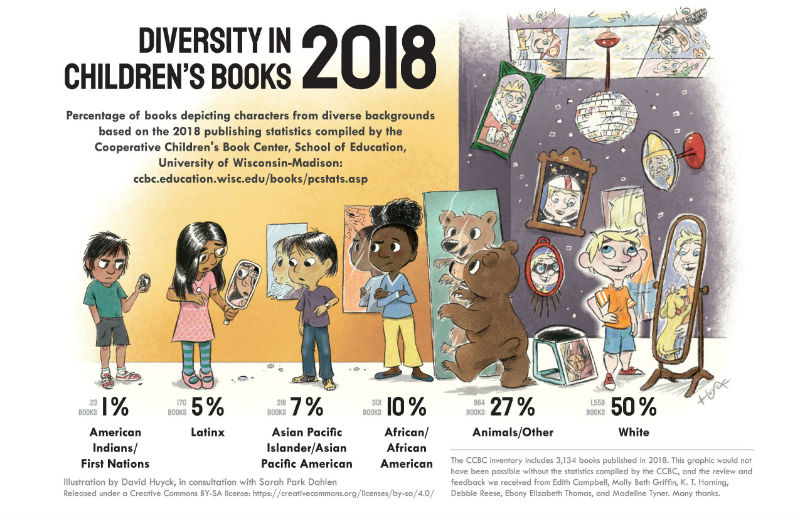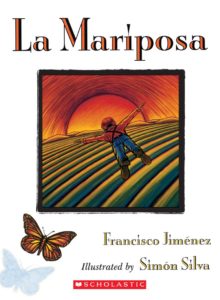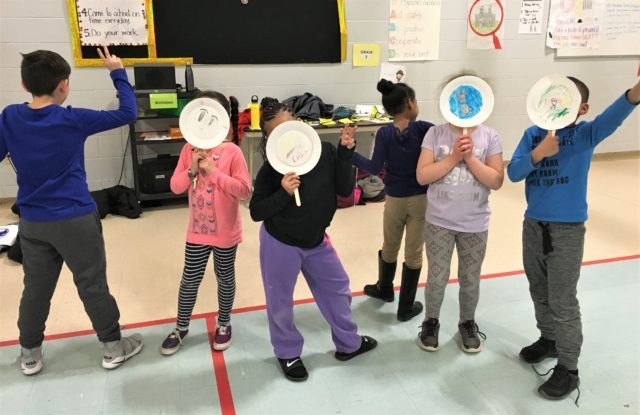A Promise to Our Students: Including Diversity in Literature
When I remember my childhood, I see the reading nook in my first-grade classroom, my mom helping me to pick a book in our town library, and my friends and I chatting at lunch about the books we wanted to read. Books were, and continue to be, the way in which I learned about the world and my own identity. Without them, I don’t think that I would be the person I am today.
Growing up I never questioned who was in the stories I was reading. Everyone looked like me and had similar backgrounds to my own. It wasn’t until I was older that I realized my privilege and the lack of representation in most of the stories I read in school. I invite you, dear reader, to picture your experiences with literature growing up. If you examine the books you grew up reading, ask yourself: who is represented in those books? Are you able to see yourself in the characters and experiences you read about? Some of you will have a very similar experience to my own. However, many people, including many of our students, have not had that same privilege.
The statistics back up the observations. In 2018, 50% of characters in children’s literature were white. The second largest group was not another race, but animals with 27%. A UK study from 2017 revealed that male characters are twice as likely to be the main character than female ones. Even if they are not the main character, there are three male characters for every two female characters in children’s literature. The study also reflects the gender binary, as non-binary characters often are not represented at all in children’s literature. LGBTQ+ characters have begun to show up in greater numbers in Young Adult literature but remain largely underrepresented in both the books elementary school students are reading and in the lessons that teachers provide these students. Often even more overlooked than these identities is representation for people with disabilities in literature.

The reality of representation in children’s literature and literacy education perpetuates the stereotypes and power dynamics present in our society. When characters of any minority race, gender, sexual orientation, etc. show up in a story, they are too often relegated to a stereotype. These stereotypes continue to spread until they become almost synonymous with fact. This is not only completely unjust, but also harmful to our youth, who learn the most about themselves from what society tells them.
Everyone has the right to see themselves in the stories they come across, especially in school when they are learning about who they are in the world. Students of color should see themselves as the main characters of their own stories. Students of all genders need to learn about the ways in which characters reject the gender binary and express their gender identity. Students of all sexual orientations need to see love in all its forms. Students with disabilities should be reminded of their potential to do whatever they set their minds to. If students see themselves authentically represented in the media they engage with, these stories validate their identities. They are reminded that stories can be created for them, not just something they’re forced to learn in school. Maybe someday, they will be the ones telling the stories that need to be told.
We all need to ensure that our students are represented in the literature and resources we give them.
 But this promise is easier said than done. When I think back to my 5th grade class last year, there were not a lot of stories we read or that they had access to in the library that truly represented my students. I distinctly remember the day we read La Mariposa by Francisco Jimenez, a story about a Mexican immigrant who is forced to assimilate into an English-only classroom. Two of my students in my small group were English Language Learners and their eyes lit up when they recognized themselves in the main character. While before I had prided myself in my knowledge about diverse literature, I then realized that knowledge is not the same as action. I needed to do better.
But this promise is easier said than done. When I think back to my 5th grade class last year, there were not a lot of stories we read or that they had access to in the library that truly represented my students. I distinctly remember the day we read La Mariposa by Francisco Jimenez, a story about a Mexican immigrant who is forced to assimilate into an English-only classroom. Two of my students in my small group were English Language Learners and their eyes lit up when they recognized themselves in the main character. While before I had prided myself in my knowledge about diverse literature, I then realized that knowledge is not the same as action. I needed to do better.
Luckily, there are so many resources out there for educators who want to teach literature equitably. I use Teaching Tolerance for sessions with my students and Rich in Color to learn about diverse Young Adult books for both myself and my middle schoolers. I also follow several Instagram accounts such as @inclusivestorytime and @thetinyactivists that post about diverse children’s literature. While writing this post, I also discovered Disability in Kidlit, which I will use to both educate myself and my students. These resources are just a few that exist. They keep my promise in the front of my mind and help me find tools to bring back to my students. I highly recommend exploring what’s out there to help you keep your own promise.
As educators, we need to help our students become experts in the most important subject matter they can ever learn about: themselves.

Related stories
A year of service with City Year is impactful for communities and transformative for the young people who serve. As...
Read more about Top 5 Reasons to Join City Year New HampshireConnecting with the Corps – An AMC MLK Experience Did you know that Dr. Martin Luther King Jr.’s Day is...
Read more about Living the LegacyReflecting on my Time at City Year Maddy Allen ’17 Upon reflecting on my time at City Year, I realized...
Read more about Maddy Allen - Reflecting on my time at City YearEach quarter, the Excellence in Service Award recognizes an ACM, SL, and Staff member for their commitment to the ideals...
Read more about Celebrating Excellence in Service – Spring 2022















